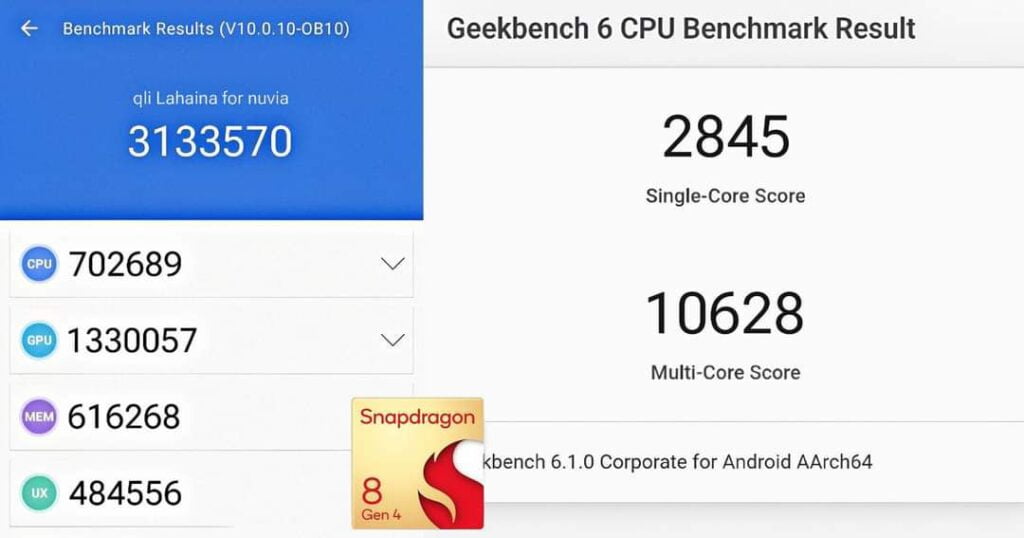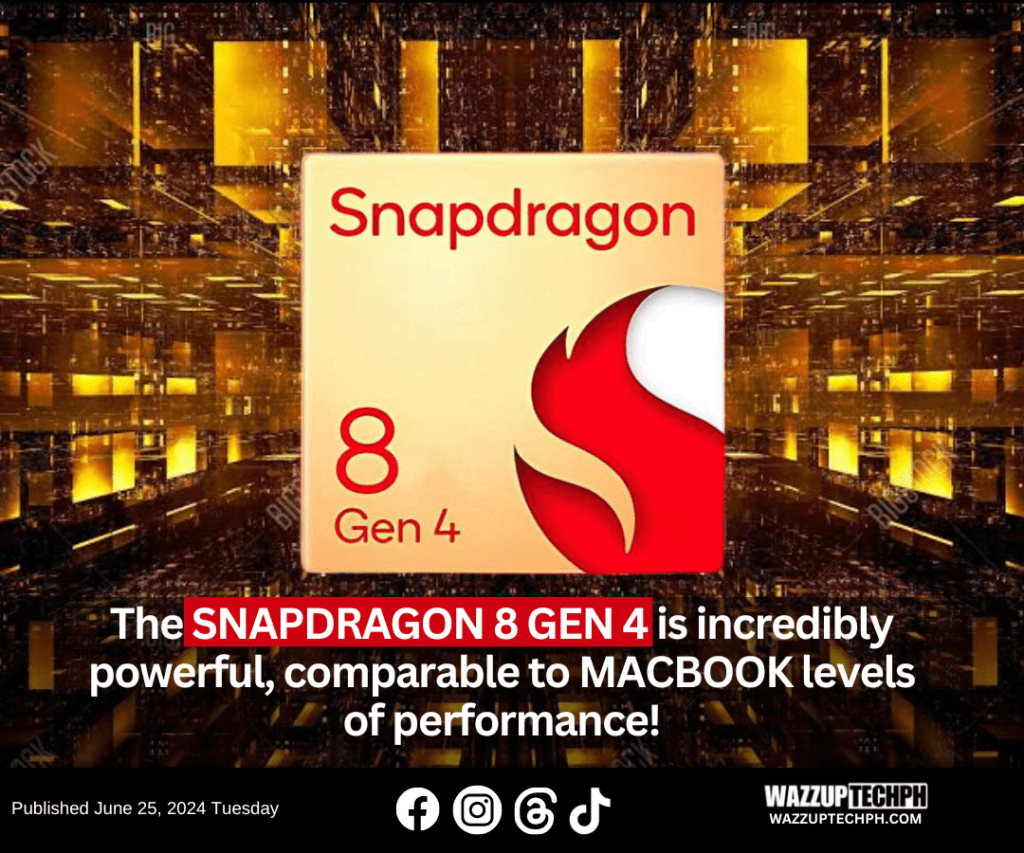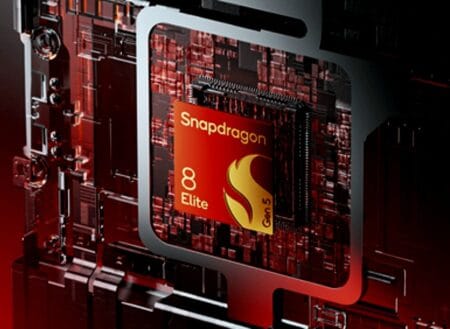This SoC has now exceeded every aspect of the Apple A series, and here’s why it’s so exciting!
The Snapdragon 8 Gen 4 has unveiled new “Phoenix” cores aimed at enhancing performance significantly. Leaked benchmarks demonstrate impressive results for this chipset, especially in multi-core performance on Geekbench 6, improved GPU performance, enhanced NPU performance, and efficiency. Details suggest the chipset is exceptionally powerful, rivaling Apple M3 chip (MacBook) levels of performance.
Enhanced CPU Performance
Performance Cores: The Snapdragon 8 Gen 4 is rumored to incorporate “Phoenix” performance cores, expected to offer superior performance compared to its predecessors. This custom CPU design aims to enhance both single-core and multi-core performance, albeit potentially leading to higher power consumption.
Geekbench 6 Scores: Leaked Geekbench 6 scores for the Snapdragon 8 Gen 4 are remarkable. It reportedly achieved a single-core score of 2,845 and a multi-core score of 10,628, signifying a significant 46% improvement in multi-core performance over the Snapdragon 8 Gen 3.

Fabrication Process: The Snapdragon 8 Gen 4 is anticipated to be manufactured using TSMC’s 3nm ‘N3e’ fabrication process, expected to address concerns about power consumption. This advanced process technology is likely to contribute to enhanced efficiency and overall chipset performance.
Comparison with Apple’s M3: Compared to Apple’s M3 chip, the Snapdragon 8 Gen 4 appears to match in both single-core and multi-core performance based on leaked benchmarks. This suggests a competitive advantage for Qualcomm’s chipset in CPU performance, validating the shift to a custom CPU design.

The Snapdragon 8 Gen 4’s improved CPU performance, highlighted by the introduction of “Phoenix” cores and impressive Geekbench 6 scores, positions it as a promising contender in smartphone processors, potentially surpassing Apple’s M3 in certain aspects.
GPU Performance
The Snapdragon 8 Gen 4 chipset brings significant improvements to GPU performance, alongside efficiency enhancements due to the new 3nm fabrication process.
Adreno GPU Enhancement: The Snapdragon 8 Gen 4 is expected to feature the Adreno 830 GPU, delivering notable performance upgrades compared to its predecessors. This enhanced GPU capability is crucial for powering graphics-intensive applications and games on mobile devices.
Benchmark Results: According to leaked benchmark results, the Snapdragon 8 Gen 4 demonstrated substantial GPU performance gains. In an early 3DMark Wild Life Extreme benchmark test, the chipset scored 7,200 points, outperforming the Apple M2’s GPU by around 10%j, indicating a promising leap in graphical processing capabilities.
Gaming Performance: The enhanced GPU performance of the Snapdragon 8 Gen 4 is set to elevate the gaming experience on mobile devices. The chipset’s ability to smoothly run demanding games like Genshin Impact at native 1080p resolution signifies a significant advancement in graphical capabilities, ensuring a more immersive gaming experience for users.
Overall, the Snapdragon 8 Gen 4’s improved GPU performance, coupled with the utilization of a new 3nm fabrication process, positions it as a powerhouse in mobile processors, promising enhanced graphical capabilities, energy efficiency, and overall performance for upcoming flagship devices.
Enhanced NPU Performance
The Snapdragon 8 Gen 4 chipset introduces enhancements to its Neural Processing Unit (NPU), meeting the increasing demands for AI-related tasks and model usage in modern tools powered by the SoC.
Hexagon NPU: The Snapdragon 8 Gen 4 incorporates a Hexagon NPU designed to accelerate AI-related computations and tasks efficiently. This dedicated NPU is essential for handling machine learning algorithms, neural networks, and other AI-driven functionalities on the chipset.
AI Acceleration: NPU improvements in the Snapdragon 8 Gen 4 aim to provide accelerated AI performance, enabling faster processing of AI workloads and enhancing the overall AI capabilities of devices powered by this chipset. The enhanced NPU is expected to optimize AI-driven applications and services for a smoother user experience.
AI Model Usage: With advancements in the NPU of the chipset, users can anticipate better support for AI model usage in various applications and tools, including image recognition, natural language processing, voice assistants, and other AI-driven features relying on the NPU’s processing power.
Efficiency and Performance: Improved NPU performance not only enhances the efficiency of AI tasks but also contributes to overall system performance. By offloading AI-related computations to the dedicated NPU, the Snapdragon 8 Gen 4 can deliver faster and more responsive AI functionalities while maintaining energy efficiency.
Future-Proofing for AI: The enhanced NPU in the Snapdragon 8 Gen 4 underscores Qualcomm’s commitment to advancing AI capabilities in mobile devices. By boosting NPU performance, the chipset is better equipped to handle the growing demands of AI technologies, ensuring seamless operation of future AI-driven applications and tools.
The chipset improved NPU performance signifies a significant advancement in AI processing capabilities, enabling more efficient and powerful AI-driven features in smartphones and other devices equipped with this chipset.
Efficiency
The Snapdragon 8 Gen 4 chipset introduces several advancements aimed at optimizing efficiency, including new core designs and leveraging the latest 3nm TSMC process technology.
Phoenix Cores Optimization: The chipset features new ‘Phoenix’ cores designed to offer a balance of peak performance and efficiency. These cores are optimized to deliver high performance while being energy-efficient, ensuring a seamless user experience without compromising power consumption.
Core Design Efficiency: Core designs in the Snapdragon 8 Gen 4 prioritize both performance and efficiency. By optimizing the configuration of high-performance cores alongside efficiency cores, Qualcomm aims to strike a balance delivering superior processing capabilities while maintaining energy efficiency for extended battery life on devices powered by this chipset.
3nm TSMC Process Technology: The chipset leverages the cutting-edge 3nm TSMC process technology, specifically the N3e node. This advanced process node allows for a significant increase in transistor density compared to the previous generation, resulting in improved power efficiency and overall performance gains. Utilizing the 3nm process technology enhances the efficiency of the chipset, contributing to better power management and reduced energy consumption.
Efficiency and Performance Balance: Qualcomm’s focus on optimizing efficiency in the Snapdragon 8 Gen 4 is evident in its core architecture and utilization of advanced process technology. By striking a balance between performance and efficiency, the chipset offers a powerful yet energy-efficient solution for flagship smartphones, ensuring optimal performance while maximizing battery life.
Enhanced Power Management: Efficiency enhancements in the Snapdragon 8 Gen 4 extend to power management, enabling devices powered by this chipset to deliver sustained performance while minimizing power consumption. This translates to a smoother user experience, improved multitasking capabilities, and better overall efficiency in handling various tasks and applications.
The chipset efficiency improvements, driven by core optimization and the adoption of the latest 3nm TSMC process technology, underscore Qualcomm’s commitment to delivering a high-performance chipset prioritizing energy efficiency and overall system optimization.
Discover more from wazzuptechph
Subscribe to get the latest posts sent to your email.








